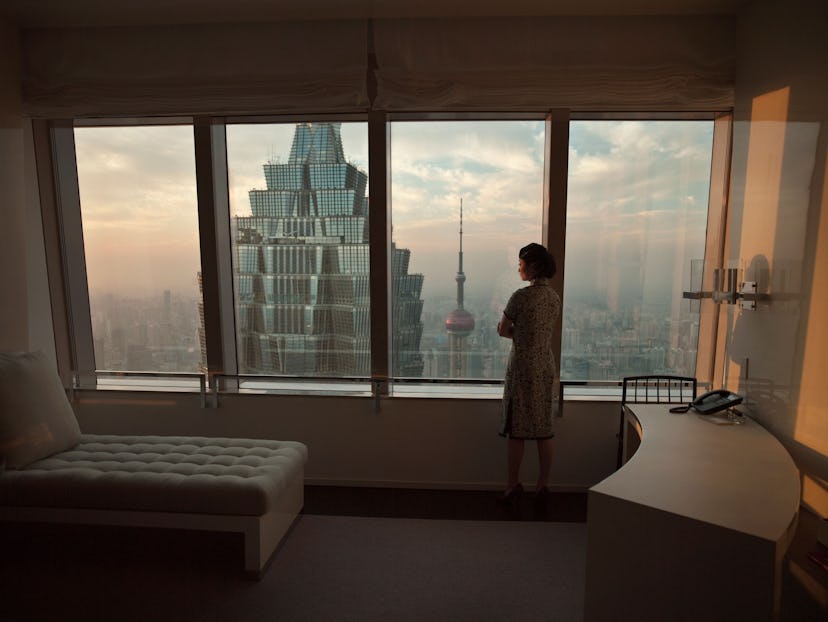Isaac Julien: Ten Thousand Waves

On Monday morning, Isaac Julien stood in the second-floor atrium of the Museum of Modern Art, greeting well-wishers and reporters in his gentle, courtly manner. High above him hung nine double-sided screens, some 23 feet wide, projecting the British artist’s most ambitious work to date, Ten Thousand Waves. Moved by the Morecambe Bay tragedy of 2004, when 23 Chinese migrant workers drowned off the coast of northwest England, Julien created a 50-minute film that flits among the nine screens with visions of both modern and ancient China: found footage of the aftermath, shots of bustling Shanghai, reconstructions of pre-WWII Chinese films, and lushly imagined scenes starring actress Maggie Cheung (from In the Mood for Love) as the goddess Mazu, a deity of Chinese fable who was said to protect those imperiled at sea.
When he first showed the piece in Shanghai, in 2010, the Chinese audience took a curious interest in Julien. Here, after all, was a born Londoner making art about the plight of Chinese emigrants seeking new starts in the West. But Julien knows something about this struggle. Before he was born, his family moved to London from St. Lucia, in the Caribbean. “There’s a lot of debate in the U.K. about migrant workers right now,” Julien explained. “One which I think isn’t very sympathetic to these people searching for a better life. I wanted to make a work that would be like a form of reparation.”
As he spoke, viewers seated on sectionals in the atrium arched their necks toward the screens, whose arrangement resembled an archipelago not unlike the islands of the Caribbean. Every once in a while, someone would get up, move to a different vantage point, and resume watching. Julien observed these movements quietly. Since the late ’80s, he has made his reputation with immersive, multi-channel video installations. At his current solo exhibition at Metro Pictures in Chelsea, Julien is showing his new film Playtime across two screens. (It stars, most prominently, James Franco as a vulture-like art dealer.) Throughout December, a three-minute version of the film will be splashed across 17 video billboards in Times Square every night just before midnight (except on New Year’s Eve).
For the many international tourists streaming through Times Square during the holidays, it will be a surreal introduction to Julien’s art. The exposure can only help his search for a more diverse dialogue. “I see myself having a transnational conversation,” he said.
“Isaac Julien: Ten Thousand Waves” is on view through February 17, 2014, at MoMA in New York, 11 W. 53rd St.
Photos: Isaac Julien: Ten Thousand Waves
Isaac Julien. Maiden of Silence (Ten Thousand Waves). 2010. Courtesy of the artist, Metro Pictures, New York and Victoria Miro Gallery, London.
Isaac Julien. Blue Goddess (Ten Thousand Waves). 2010. Courtesy of the artist, Metro Pictures, New York and Victoria Miro Gallery, London.
Isaac Julien. Hotel (Ten Thousand Waves). 2010. Courtesy of the artist, Metro Pictures, New York and Victoria Miro Gallery, London.
Isaac Julien. Ten Thousand Waves. 2010. Installation view at The Museum of Modern Art. Photo by Jonathan Muzikar.
Isaac Julien. Ten Thousand Waves. 2010. Installation view at The Museum of Modern Art. Photo by Jonathan Muzikar.
Isaac Julien. Ten Thousand Waves. 2010. Installation view at The Museum of Modern Art. Photo by Jonathan Muzikar.
Isaac Julien. Ten Thousand Waves. 2010. Installation view at The Museum of Modern Art. Photo by Jonathan Muzikar.
Isaac Julien. Mazu,Turning (Ten Thousand Waves). 2010. Courtesy of the artist and Victoria Miro Gallery, London.
Isaac Julien. Nanjing Road Tram (Ten Thousand Waves). 2010. Courtesy of the artist, Metro Pictures, New York and Victoria Miro Gallery, London.